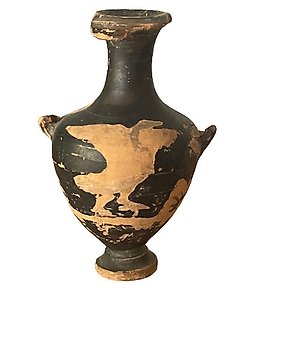
Antikens Grekland Keramik Hydria. Spansk exportlicens - 10.4×7.5×10.4 cm
Nr 46956551

Nr 46956551

Red-figured pottery volutes krater, decorated with figurative motifs and faces in relief on the handles, above the turn of the scroll. The handles are fretworked at the base, where they are decorated with duck heads with curved necks worked in the round.
On the obverse, the composition is dominated by two figures inside a naiskos or temple with a base decorated with palmettes, two Ionic columns, entablature and triangular pediment, lowered to fit the frame. The naiskos is surrounded by offerers (two men and two women) carrying boxes, trays, branches and floral wreaths. Inside the shrine is a standing warrior, wearing breastplate, mantle and helmet adorned with feathers or wings, holding a spear in his right hand and a round shield in his left. Next to him stands a bearded man, dressed in toga, who offers him an ornate goblet.
On the opposite side, the reverse or side B, we see four other offerers similar to those on the obverse, two women dressed in chiton and two naked men, wearing cloaks, carrying objects similar to those on the front. They are placed around a commemorative pillar decorated with ribbons and garlands, with floral motifs on the base and a triangular pediment at the top.
On the sides, separating the two scenes, are large palmettes decorated with synthesised vegetal scrolls, with a sinuous outline, and other smaller palmettes. This decoration on the belly is framed at the top and bottom by borders, the lower one with fretwork and the upper one with gadroons and ovals.
The neck is also richly decorated with figurative motifs. On the A side is a winged bust rising from a goblet, surrounded by intricate vegetal motifs including flowers, lobed leaves and sinuous ribbons. On the reverse side, also on a goose-crowned cup that starts from a series of lobed leaves, we see a male bust with goat's horns, depicted in profile and flanked by motifs that are simpler than those on the front, palmettes similar to those that adorn the sides of the belly. Above this band with figurative decoration, we see a border with synthesised laurel wreaths and small flowers and, above it, an inverted border of sea waves, also with a synthesised design. Finally, the mouth, which is hollowed out, is decorated on the outside with waves similar to those we see brushstrokes on the shoulders. The foot is tall and narrow, with no decoration other than two thin, smooth bands in red on a polished black background.
Kraters were ceramic vessels used to contain liquids such as water or wine. This type of krater, which we call a scroll krater because of the way the handles are finished, is very characteristic.
The importance of these items is even mentioned in Homer's Odyssey, in Book VIII. The best known function of the kraters is their use as a gift to the winners of the Athenian games, parallel to the prize that is awarded today. Although we must analyse its use from the earliest wartime uses, when it was used as a gift to the defeated people in battle, even being used to pour liquids over the dismembered enemies.
The volute krater is characterised by its handles, which protrude above the mouth forming spirals, and was produced until the 4th century BC, so the one presented here is a late example.
This krater comes from the region of Apulia, in southern Italy, where Daunia, now the province of Foggia, and Messapia, in the southern part of the region, are located
This krater is decorated by the Underworld painter, who was an ancient Greek Apulian vase painter whose works date to the second half of the 4th century BC. He was the successor of the Darius Painter, in whose workshop he began his career and where he worked with other influential craftsmen. He most frequently depicted theatrical scenes, especially ones from the Classical tragedies by Euripides, and mythological themes.
TL Test attached, see pictures.
Provenance: Belgian private collection, 1970s / J. Bagot Archaeological Gallery, Barcelona, 2015
Exhibited: Ifergan Collection, Málaga (2018-2020)
Statement seen by Catawiki. Important information. The seller guarantees that he is entitled to ship this lot. The seller will take care that any necessary permits will be arranged. The seller will inform the buyer about this if this takes more than a few days.
Important: For destinations out of Spanish territorry: all our object will be shipped after obtaining CERTIFICATE OF EXPORTATION by Ministry of Culture of Spain. We inform our clients that it may take between 4-8 weeks.
According to Spanish legislation, items sent outside the European Union are subject to export taxes and will be added to the invoice, at the buyer's expense.
These export fees are fixed on the final auction price and the tax rate is not applied directly on the total value of the item to be exported, but rather the different percentages by sections are applied to it:
- Up to 6,000 euros: 5%.
- From 6.001 to 60.000 euros: 10%.
- From 60,001 to 600,000 euros: 20%.
Hur du köper på Catawiki
1. Upptäck något speciellt
2. Lägg det högsta budet
3. Gör en säker betalning